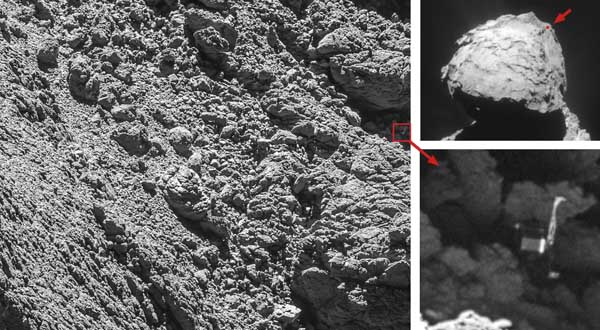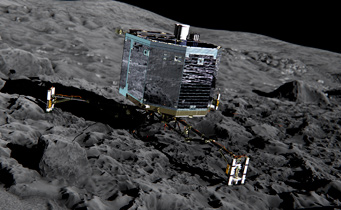It's taken nearly two years, but a dedicated search of craggy Comet 67P/Churyumov-Gerasimenko has turned up the long-lost landing craft Philae.
A key objective of the European Space Agency's Rosetta mission was to place an instrumented, washing-machine-size craft called Philae on the surface of Comet 67P/Churyumov-Gerasimenko. But not much went right during the landing attempt on November 12, 2014. Two systems designed to anchor the craft on the comet's rock-and-ice nucleus — a downward-pushing thruster and two harpoons — both failed. Set free in the comet's ultra-low gravity, Philae bounced twice before finally coming to rest far from its intended touchdown site.
The craft wasn't destroyed by all that, but it didn't land upright and ended up mostly in shadow. Unable to generate enough electricity via its solar-cell panels, Philae transmitted for 57 hours before it shut down.
Back on Earth, ESA engineers started the hunt for where, exactly, Philae had ended up. Mission engineers had a rough idea of the landing site's location, a craggy spot on the smaller of Comet 67P's two elongated lobes (they even named it: Abydos). And hope surged 8 months later, when the Sun-warmed lander came to life long enough to fire off a few brief transmissions. But it wasn't enough for Rosetta, the orbiting mother ship, to identify the landing site.
However, ESA announced today that Philae has, at last, been found. As suspected, the lander lies wedged in a deeply shadowed crevice. It's tipped over onto one side, with two of three legs in view. Given that orientation, it's little wonder why the search took so long.

ESA / Rosetta
Still, the mission team is thrilled. In less than a month (September 30th), they'll command Rosetta to drop to the comet's surface. So time to complete the search was clearly running out.

ESA / ATG medialab
The discovery came on September 2nd, with Rosetta just 2.7 km (1.7 miles) above the comet's nucleus. From that altitude, the telephoto half of the orbiter's OSIRIS camera could resolve details as small as 5 cm (2 inches). Finding the lander is more than a sentimental achievement; it will provide context for the scientific and engineering data that Philae managed to transmit to Earth.
"Now that the lander search is finished, we feel ready for Rosetta's landing and look forward to capturing even closer images of Rosetta's touchdown site,” notes Holger Sierks, principal investigator for OSIRIS, in today's announcement.
 4
4
Comments
Anthony Barreiro
September 7, 2016 at 4:24 pm
It's hard not to anthropomorphize this brave little lander. Well done Philae -- you were the first, second, and third craft to set down on a comet! And despite your unfortunate final landing spot and awkward position, you continued to do your job as well as you could.
Kudos to the Rosetta team for finding Philae, and for a highly successful mission overall.
You must be logged in to post a comment.
Ulrich Koehler
September 10, 2016 at 4:33 am
The landing was on November 12, 2014, BTW, not 15; the failure of the downward-pushing thrusters was not so much a problem since they have been designed for the landing on comet Wirtanen, the target of Rosetta before the delay of the mission's launch - with an even weaker gravity field on Wirtanen. The harpoons have been the mishap, yes. It's a bit too negative to me what is written here: with the primary battery science for more than 60 hours was possible - and done, all ten experiments have performed at least once, as laid down in the (then quickly adapted) First Science Sequence. Rosetta, with Philae, is a milestone in the exploration of the solar system comparable to Viking and Voyager. A great mission and a great adventure for all that followed the events and shared the excitement during these two years. Happy landing, Rosetta, in two weeks!
You must be logged in to post a comment.
J. Kelly BeattyPost Author
September 12, 2016 at 10:28 am
hello, Ulrich... ah, yes, it was indeed 12 November 2014. now fixed!
You must be logged in to post a comment.
Graham-Wolf
September 11, 2016 at 9:46 pm
Congrats to the hard working Rosetta Team!
They kept on trying, when the general public had long since capitulated.... now Philae has been located at last! The best possible outcome, has happened. Keep hanging in there... you wonderful little lander.
Even more reason now, to grab a 1m class 'scope and have another look at Comet 67p. Regards from NZ. Graham W. Wolf
You must be logged in to post a comment.
You must be logged in to post a comment.